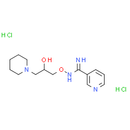Description
BGP-15 is a PARP inhibitor, with an IC50 and a Ki of 120 and 57 μM, respectively.
Product information
CAS Number: 66611-37-8
Molecular Weight: 351.27
Formula: C14H24Cl2N4O2
Chemical Name: N-[2-hydroxy-3-(piperidin-1-yl)propoxy]pyridine-3-carboximidamide dihydrochloride
Smiles: Cl.Cl.N=C(NOCC(O)CN1CCCCC1)C1C=CC=NC=1
InChiKey: ISGGVCWFTPTHIX-UHFFFAOYSA-N
InChi: InChI=1S/C14H22N4O2.2ClH/c15-14(12-5-4-6-16-9-12)17-20-11-13(19)10-18-7-2-1-3-8-18;;/h4-6,9,13,19H,1-3,7-8,10-11H2,(H2,15,17);2*1H
Technical Data
Appearance: Solid Power
Purity: ≥98% (or refer to the Certificate of Analysis)
Solubility: DMSO : 11.33 mg/mL (32.25 mM; Need ultrasonic and warming). H2O : 100 mg/mL (284.68 mM; Need ultrasonic).
Shipping Condition: Shipped under ambient temperature as non-hazardous chemical or refer to Certificate of Analysis
Storage Condition: Dry, dark and -20 oC for 1 year or refer to the Certificate of Analysis.
Shelf Life: ≥12 months if stored properly.
Stock Solution Storage: 0 - 4 oC for 1 month or refer to the Certificate of Analysis.
Drug Formulation: To be determined
HS Tariff Code: 382200
How to use
In Vitro:
BGP-15 (200 μM) prevents the imatinib mesylate-induced oxidative damages, attenuates the depletion of high-energy phosphates, alters the signaling effect of imatinib mesylate by preventing p38 MAP kinase and JNK activation, and induced the phosphorylation of Akt and GSK-3beta.
In Vivo:
BGP-15 (15 mg/kg, p.o.) does not improve skeletal muscle pathology in older mdx mice. In a rat model, 10 days of BGP-15 treatment greatly improves diaphragm muscle fiber function (by about 100%), although it does not reverse diaphragm atrophy. The treatment also provides protection from myosin PTMs associated with HSP72 induction and PARP-1 inhibition, resulting in improvement of mitochondrial function and content. BGP-15 (15 mg/kg per day in saline) treatment has no effect in Ntg mice or an independent cohort of normal adult wild-type mice based on morphology, cardiac function and ECG parameters. Treatment with BGP-15 attenuates the increase in atrial size and lung weight. BGP-15 treatment is able to prevent or reduce episodes of arrhythmia. BGP-15 treatment is associated with a reduced PR interval in the HF+AF model. BGP-15 (10 and 30 mg/kg) increases insulin sensitivity by 50% and 70%, respectively, in cholesterol-fed but not in normal rabbits. After 5 days of treatment with BGP-15, the glucose infusion rate is increased in a dose-dependent manner in genetically insulin-resistant GK rats. The most effective dose is 20 mg/kg, which shows a 71% increase in insulin sensitivity compared to control group.
Products are for research use only. Not for human use.
Payment & Security
Your payment information is processed securely. We do not store credit card details nor have access to your credit card information.


